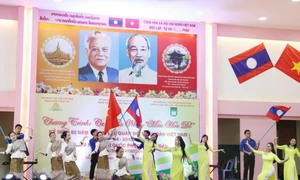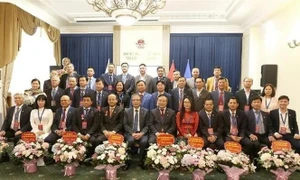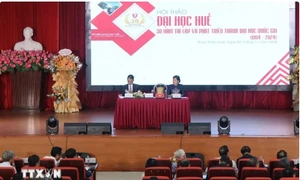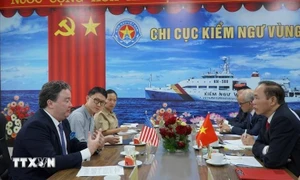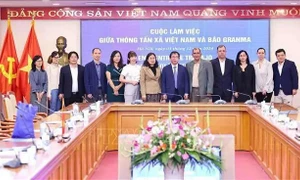From the viewpoint of a lawmaking agency, what are the new points of the 2023 Law on Water Resources?
Law No 28/2023/QH15 on Water Resources was approved with many new points that will greatly change the way water resources are currently managed in Việt Nam.
One of the key highlights and the core principle of the law is that water supply must be managed in a comprehensive and integrated manner in terms of quantity and quality, surface and underground, upstream and downstream water. It also defines clear responsibilities for State management in terms of water supply and resources, notably the planning, construction and operation of irrigation, hydropower, as well as urban and rural water supply structures. This is the foundation to improve Việt Nam’s water security.
The law was also built in a way that regulates all aspects of management, protection and use of water resources, preventing and controlling water-induced damage, while clearly defining “what to manage, how to manage and who will manage".
The law specifies the responsibilities of the Ministry of Natural Resources and Environment, the Ministry of Agriculture and Rural Development and the Ministry of Construction, among others, in alignment with their missions in related laws to ensure cohesion and comprehensiveness; addressing the overlapping and conflicting clauses as well as the “gaps” in these laws to improve the effectiveness and efficiency of the State management regarding water resources, ensuring the national water security.
On that basis, water resources, regulated in a cohesive and synchronised manner, will be distributed for different purposes and to various localities according to the water management scenarios for the water security of the country.
The law stipulates that the priority is urbanisation and professionalisation of water resources management, aiming to monitor the country’s water resources on digital platforms through the national water resources information system and database, as well as other instruments that aid the decision-making process.
Therefore, in the near future, digital platforms will be increasingly applied in supporting management agencies in their decision-making process on regulating and distributing water resources, operating reservoirs and inter-reservoirs, mitigating water-induced damage, especially in the case of drought and water shortages at river basins, thereby optimising human resources as well as operational and management costs.
What are the key regulations included in the 2023 Law on Water Resources to address the challenges in water security, especially in major cities?
Water resources in Việt Nam are indeed facing many challenges. In fact, 60 per cent of our water (approximately 504.4 billion cubic metres) depends on foreign sources. Meanwhile, local water is unevenly distributed and the dry season lasts seven to nine months.
On the other hand, water demand increases rapidly along with the pressure of socio-economic development. Specifically, on average over the past 50 years, the demand for water has increased three-fold due to population growth, agricultural and industrial development and urbanisation. It is estimated that by 2030, water demands for industries will reach about 122.47 billion cubic metres per year.
In addition, worsening water pollution, and increasing industrial and agricultural production that leads to untreated and unqualified wastewater discharge, have impacted and put a growing, serious burden on the water quantity and quality in rivers, streams and aquifers, especially Nhuệ and Đáy river basins, Cầu River and the Bắc Hưng Hải irrigation system.
According to the World Bank, water pollution can reduce GDP (gross domestic product) by 4.3 per cent each year. If Việt Nam does not carry out radical solutions for wastewater treatment problems, its GDP will decrease by 2.5 per cent in 2035.
Facing these challenges, the 2023 water resources law legislates new directions, strategies and policies of the Party and the State in managing and protecting water resources; in which policies on water security are present throughout the chapters and articles.
The goal is that by 2030, Việt Nam aims to improve national water security to be among the Southeast Asian countries with effective water security and on par with developed countries globally; ensuring the quantity and quality of domestic water in all scenarios, responding to water demands for socio-economic development, national defence and security, environment; and mitigating risks and damage from natural and human-induced water disasters.
 |
| Bắc Hưng Hải, one of the largest irrigation systems in the northern region, has been suffering from pollution due to untreated wastewater from residential areas and small production zones. — VNA/VNS Photo Vũ Sinh |
How will the regulations in the 2023 Law on Water Resources contribute to reviving polluted or dried-up rivers?
I have high hopes for reviving and restoring these “dead rivers” in this amendment.
For specific legal frameworks, the 2023 Law on Water Resources added multiple policies and regulations related to reviving rivers. To ensure the scientific basis and feasibility, it also stipulates clear financial policies and mechanisms for restoring water supply, paving the way for resource mobilisation and distribution to revitalise degraded, depleted and polluted water.
The law also has regulations on devising plans, programmes and projects to restore degraded, depleted and polluted water supply; with priority given to the “dead rivers” to revive these streams; including priority programmes and projects reviving Bắc Hưng Hải, Nhuệ and Đáy rivers by constructing dams to facilitate flows.
In addition, the 2023 water resources law also legislated regulations on the minimum flow to minimise the impact of upstream flow regulating constructions, dams and reservoirs on the stream, contributing to reviving “dead rivers” across the country.
How does the 2023 Law on Water Resource legislate the economicisation of water supply, especially in major cities?
One of the new points included in the law is shifting from managing through administrative means to economic means. This is a modern approach that has been applied in many developed countries around the world such as France, Australia, South Korea and the US.
Accordingly, the law added regulations on the fees required to be granted rights to capitalise on water resources in order to raise awareness of water protection and the economical use of water.
Particularly, in case of drought or water shortage, water distribution to water-intensive or non-urgent activities will be limited, and instead, prioritised for domestic use and activities that make use of water effectively and economically.
What can be done in the near future to mobilise the power of the people for water protection efforts?
I think when any law is approved, including the 2023 Law on Water Resources, integrating the policies within the law into daily life is a key factor in assessing the law’s success.
Therefore, since the drafting phase, we reviewed and evaluated the implementation of the 2012 water resources law, and identified the current shortcomings in order to develop policies that fit Việt Nam’s actual context (from water management, protection, exploitation and use to the prevention and control of water-induced damage as well as the compatibility with the country’s resources).
The 2023 Law on Water Resources added regulations on the funding to protect and develop water resources (including private capital; regulations that prioritise privatisation for investment to water development, storage and supply revival as well as preferential policies). The direction is economic development in alignment with “reinvestment” into water resources protection and development, as well as landscape renovation.
What are the expectations of the Ministry of Natural Resources and Environment when the 2023 Law on Water Resources is passed and put into application?
The issuance of the new water resources law will be a crucial transformation in the thinking, approach and management of water sources, bearing special significance.
With major, breakthrough and important policies in this water resources law, the Ministry of Natural Resources and Environment has great expectations and believes that the law will be enacted effectively and comprehensively to address the challenges to water resources under the pressure of socio-economic development; while also meeting the requirements of the Party and the State regarding water resources management and protection, especially in improving national security to be near the same level as developed countries in the world.
It is hoped that in the next five to ten years, water resources will be sustainably managed and reflect their value as a public asset, and that people will have access to fair, clean and safe water supply. — VNS
